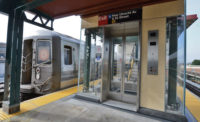Project Delivery
Can a P3 Make New York Subways More Accessible to Disabled Users?

An out-of-service New York City subway elevator in 2019.
Photo, slightly cropped: TDorante10 under CC By-SA 4.0 via Wikimedia Commons.
The subway entrance at 39th Street and Avenue of the Americas in midtown Manhattan is an inconvenience and irritation for disabled transit users—including staff of the Center for the Independence of the Disabled, NY, an advocacy organization based nearby.
Thousands of daily riders go through station turnstiles. The entrance's main value to the disabled or those with strollers, luggage or packages was the ability to reach the train platform level by elevator.
But since last August, the elevator has been out of service, says Jeff Peters, the center’s spokesman. “We have to deal with this unfortunate situation daily,” he says, requiring longer trips to the station’s nearest still-functioning elevators.
The New York City subway system, compelled by lawsuits filed by disabled advocates, is spending billions and using a public-private partnership to try to add more elevators and keep them running.
Last month, state and federal court judges in New York signed off on a settlement of a lawsuit by Peters’ organization and other plaintiffs against the operator of the city's subways. Despite being short of funds and riders, the Metropolitan Transportation Authority committed under the settlement to spend heavily to make its system more accessible.
It agreed to dedicate a sizable chunk, 14.69%—about one out of every seven dollars—of the Transit Facilities Funding amount in MTA’s 2020-2024 capital spending program to accessibility. The agency also agreed to issue requests for proposals for such work at 81 stations.
Disability Act Compliance: When?
MTA has persevered with an ambitious capital construction and maintenance program, but it has been 33 years since Congress adopted the Americans with Disabilities Act and New York City’s subway system has never been in compliance.
The agency now forecasts that compliance remains another 33 years away. While disabled advocates are frustrated and have filed lawsuits over the years, the situation has entered a new phase.
To help meet the goal, MTA has launched its first P3 specifically for the accessibility and elevators work.
At its November board meeting, the agency board approved four separate contracts with $1.2 billion worth of elevator construction and maintenance, accessibility and ADA compliance contracts, as well as an additional $7-million award for long-term escalator and elevator maintenance at the new Grand Central Madison Terminal.
The multi-station P3 procurement marked a departure for the sprawling transportation authority, which also operates the Long Island Railroad and Metro-North commuter rail systems.
The deal involved a $965-million contract award for a 13-station package of construction, finance and maintenance of elevators and other ADA improvements. It was won by a team comprised of ASTM North America, a unit of Italy-based P3 concessionaire ASTM SpA; Nanuet, N.Y.-based Halmar International, which is controlled by same the Italian firm as the design, construction and maintenance contractor; and Otis Elevator Co. as elevator supplier and maintainer.
The P3 must maintain 21 new elevators at the stations for 15 years, with options to extend.
MTA staff and board chose the ASTM team over two shortlisted competitors. One included Start America NYTAP, a joint venture of Judlau Contracting and ECCO III Enterprises and Otis as a maintenance contractor.
A third short-listed competitor consisted of Plenary Iovino Infrastructure Partners and MLJTC2 as contractors and AECOM as lead designer.
The runners up, which will each receive a $2-million proposal stipend, submitted similar financial terms with a total cost to MTA of about $1.2 billion. Each sought about $290 million in periodic progress payments, $200 million in completion payments and about $750 million in availability payments. Those payments would depend on the P3 concessionaire meeting MTA performance goals.
Unlike its competitors, the winning team sought progress payments of only $69 million, $200 million in completion payments and $696 million in availability payments.
Chris Larsen, Halmar’s CEO, says that his team will be able to provide economies of scale that make the project worthwhile as it assumes the maintenance risk. “The bigger the company, the more people there are to respond and that helps to drive costs down,” he says. Otis Elevator will have the key maintenance role, he adds, and Halmar is experienced in doing elevator-related construction.
Jamie Torres-Springer, MTA construction and development president, said in a statement in November that the P3 “allows us to get the best value for money, as our delivery partner will finance the work and maintain the elevators and then receive payments only if it meets our high standards.”
The MTA is also bundling LIRR stations “to help us get the most for each dollar” related to accessibility, said Torres-Springer.
The second largest contract that came before the MTA board in November was valued at $106.4 million. It went to Judlau Contracting Inc. for accessibility upgrades and long-term elevator maintenance, but not as part of a P3.
Skeptical Report
The poor performance by building owners on existing elevators not maintained by the MTA has already bred skepticism of the P3 plan.
The agency has granted third-party maintenance agreements in exchange for a developer’s design advantage or zoning variance to a concurrent or adjacent property.
According to a report released in February by City Council member Keith Powers, “although public-private partnerships are often touted as a route to subway accessibility, our review demonstrated that equipment maintained by third-party entities is a mixed bag.” Service outages at privately maintained elevators last longer than those on elevators maintained by MTA, his report found.
Peters is more sanguine about the P3 and related contracts.
“We’re open to anything in life that makes subways more accessible,” he says. “We just want to make sure it happens.”





